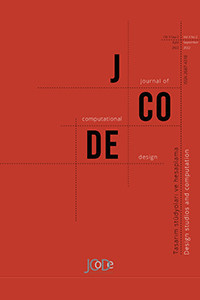Çekişmeli Üretken Ağlar ile Plan Üretimi: Haeckel'in Çizimlerinden Palladyan Planlara
Bu çalışmada, derin öğrenme ağlarının mimari tasarımdaki uygulamaları deneysel plan üretimi yoluyla araştırılmıştır. GAN (çekişmeli üretken ağ) gibi derin öğrenme ağlarının görüntü işleme yetenekleriyle, mimari görsel verilerle üretken modellerin eğitimi mümkündür. GAN türlerinden biri olan CycleGAN, görsel veri seti esnekliği ve ön işçilik gereksiniminin düşük olması nedeniyle bu çalışma için seçilmiştir. Bu çalışma kapsamında CycleGAN modelini eğitmek için veri seti olarak 2B planlar ve görseller seçilmiştir. Modeli yalnızca planlardan oluşan bir veri setiyle eğitmek ve benzer ancak yeni çıktılar ürettirmek mümkünken, bu çalışmada farklı bir veri setindeki görselleri plan benzeri görsellere dönüştürmek amacıyla iki veri seti kullanılmıştır. Planlardan oluşan veri seti için Palladio’nun planları seçilmiştir. Çünkü bu planların iki boyuttaki güçlü temsil dili ve simetrik özellikleri sayesinde, mekansal organizasyona dair gömülü veriler CycleGAN algoritması tarafından kolayca çözümlenebilir ve bir eğitim seti olarak kullanılabilir. İkinci veri seti ise, organik yapıların görsel verilerinden mekansal organizasyon oluşturma olasılıklarını araştırmak için Haeckel'in mikroorganizma çizimlerinden oluşturulmuştur. Haeckel'in çizimleri asıl mikroorganizma görselleri yerine, idealize edilmiş ve rotasyonel simetriye sahip plan benzeri figürler oldukları için seçilmiştir. Model, aralarında görsel dönüşüm yapmak için bu iki veri seti ile eğitilmiştir. Model her iki yönde de çalışabilmesine rağmen, bu makale Haeckel'in çizimlerinden Palladyan benzeri planlara dönüşümlere odaklanmış ve bu dönüşümlerin sonuçları değerlendirilmiştir. Çalışma sonunda model, Haeckel’in çizimlerini Palladio’nun planlarındaki biçimsel özelliklere sahip plan benzeri görsellere çevirmiştir. Sonuç ürünler, ön tasarım sürecine ve mimari ile alan dışı görseller arasındaki görsel dönüşümleri araştırma konusuna fayda ve ilham sağlayabilir. Bu çalışma, yapay zekâ yöntemlerinin -özellikle GAN'ların- deneysel plan üretimlerinde kullanımı açısından alana katkı sağlamaktadır.
Anahtar Kelimeler:
CycleGAN, Derin Öğrenme, Mekansal Görüntü İşleme, Mimarlıkta Yapay Zeka, Plan Üretimi
Plan Generation with Generative Adversarial Networks: Haeckel’s Drawings to Palladian Plans
In this study the application of deep learning networks in architectural design is explored via experimental plan generation. With image processing abilities of deep learning networks such as GAN (generative adversarial network), training generative models with architectural visual data is possible. One type of GANs called CycleGAN is specially chosen for the purposes of this study because of its flexibility on visual datasets and low requirement of preliminary labor. In the scope of this study, 2D plans and visuals are selected as datasets to train the CycleGAN model. Instead of training the model with only one dataset of plans and let it generate similar but novel outcomes, in this study two datasets are used to experiment on translations into plan-like images from a different dataset. For the dataset that consists of plans, Palladio’s plans are selected. Because the embedded spatial organizational data can be easily decoded and used as a training set for the CycleGAN algorithm, thanks to their potent and symmetrical representations on 2D. Second dataset is formed by Haeckel’s microorganism drawings, in order to investigate new possibilities of spatial organization when they are emerged from the visual data of organism structures. Instead of original microorganism images, Haeckel’s drawings are selected because of their idealized plan-like figures with rotational symmetry. The model was trained with these two datasets to perform image translation between them. Although the model can work both ways, this paper focused on and evaluated the translations from Haeckel’s microorganism drawings to Palladian-like plans. Eventually the model translated Haeckel’s drawings into plan-like images which shows the features of the forming patterns of Palladian plans. The outcomes can be beneficial and inspiring for the conceptual and preliminary design processes as well as studying the visual transformations between architectural and out of field visuals. This study, contributes to the field in terms of the application of AI methods -specifically GANs- in experimental plan generation tasks.
___
- ArchDaily. (2017, September 3). Plans. ArchDaily | Broadcasting Architecture Worldwide. https://www.archdaily.com/tag/plans
- As, I., Pal, S., & Basu, P. (2018). Artificial intelligence in architecture: Generating conceptual design via deep learning. International Journal of Architectural Computing, 16(4), 306–327. https://doi.org/10.1177/1478077118800982
- Balcı, O., Terzi, Ş. B., & Balaban, Ö. Çekişmeli Üretici Ağlar (GAN) İle Harita Üretimi ve Manipülasyonu. Journal of Computational Design, 1(3), 95-114.
- Çeliker, Y. E., Efendioğlu, G., Balaban, Ö. (2020). Cycle-GAN ile Modern İç Mekânların Bilim Kurgu Ortamları Olarak Yeniden Üretilmesi, JCoDe: Journal of Computational Design, 1(3), 71-94 Goodfellow, I.,
- Pouget-Abadie, J., Mirza, M., Xu, B., Warde-Farley, D., Ozair, S., ... & Bengio, Y. (2014). Generative adversarial nets. Advances in neural information processing systems, 27.
- Haeckel, E. (2013). Kunstformen der natur.
- Isola, P., Zhu, J., Zhou, T., & Efros, A. A. (2017). Image-to-image translation with conditional adversarial networks. 2017 IEEE Conference on Computer Vision and Pattern Recognition (CVPR). https://doi.org/10.1109/cvpr.2017.632
- Palladio, A. (1965). The four books of architecture (Vol. 1). Courier Corporation.
- Uzun, C., Çolakoğlu, M. B., & İnceoğlu, A. (2020). GAN as a generative architectural plan layout tool: A case study for training DCGAN with Palladian Plans and evaluation of DCGAN outputs. A| Z ITU Journal of Faculty of Architecture, 17, 185-198.
- Zhao, C. W., Yang, J., & Li, J. T. (2021). Generation of Hospital Emergency Department Layouts Based on Generative Adversarial Networks. Journal of Building Engineering, 102539.
- Zhu, J., Park, T., Isola, P., & Efros, A. A. (2017). Unpaired image-to-image translation using cycle-consistent adversarial networks. 2017 IEEE International Conference on Computer Vision (ICCV). https://doi.org/10.1109/iccv.2017.244
- Yayın Aralığı: Yılda 2 Sayı
- Başlangıç: 2019
- Yayıncı: İstanbul Teknik Üniversitesi
Sayıdaki Diğer Makaleler
Sandalye Tasarımında Üretken Çözümlerin Tasarımcısı Olarak Makine
Mimarlıkta Dijital Fabrikasyonun Sanatsal ve Şiirsel Boyutu
Kamile ÖZTÜRK KÖSENCİĞ, Yağmur Burcu GÜNEŞ
Mimaride Eklemeli Üretim Sistemlerinin Sınıflandırması için bir Öneri
Çekişmeli Üretken Ağlar ile Plan Üretimi: Haeckel'in Çizimlerinden Palladyan Planlara
Deneysel Tiyatro Sahnelerine Parametrik Biçim Grameri ile Sahne-Parter Düzeni Önerilmesi
Dijital Fabrikasyon Süreçlerinde Sanal Gerçekliğin Kitlesel Bireyselleştirmeye Dönük Kullanımı
